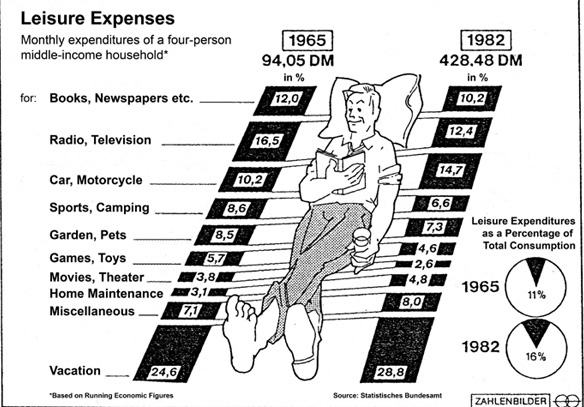Source
Leisure Expenditures
Following the adoption of the 40-hour work week, the introduction of the mostly customary six weeks of annual vacation, and the lowering of the retirement age, many people at the beginning of the 1980s now have far more time off from work, and consequently more genuine leisure, than they did ten or twenty years ago. Leisure activities account for more and more of a person’s time. At the same time, there is a strong upward trend in household spending on leisure. According to the German Federal Office of Statistics, total monthly consumer expenditures for an average four-person, middle-income, white-collar household rose from DM 881 to DM 2,691 between 1965 and 1982, or 205 percent. Expenditures for leisure, however, rose by 356 percent over the same period.
The households surveyed spent roughly DM 428 on sports and games, education and entertainment, and hobbies and vacation in 1982. This amounted to about one-sixth (15.9%) of their total spending. In 1965, by contrast, only barely 11 percent of the total consumer budget was used for leisure purposes. The observation that the average share spent on leisure goods/activities increases with total income is also confirmed in a cross-comparison between households of different income levels. Leisure expenditures account for a lower percentage of income in two-person pensioner households (1982: 9.4%) than in middle-income households. The percentage, however, is much higher in four-person, higher-income households of white-collar employees and civil servants (1982: 18.7%).
There have been some notable changes in the breakdown of leisure spending since 1965. In 1982, middle-income households spent a much higher percentage of their total leisure expenditures on vacations, cars, and home improvement equipment than they did back then. In contrast, expenditures for other leisure goods declined. The largest percentage, by far, has always been spent on vacations and recreational travel. In 1982, middle-income households spent an average of DM 123 per month on this category; this was, however, lower than in the two preceding years. Leisure travel by car accounted for an average of DM 63 per month. The third large expense category—radio, television, video, etc.—accounted for an average of DM 53 per month, a significant increase over the previous year. The households polled spent almost DM 44 on reading materials (books, newspapers, magazines). The ranking was slightly different for pensioner households as well as more affluent households of white-collar employees and civil servants. In both of these groups, books and other printed materials occupied third place [ahead of electronics].

Source: Ausgaben für die Freizeit, Zahlenbilder, September 1983, no. 9.